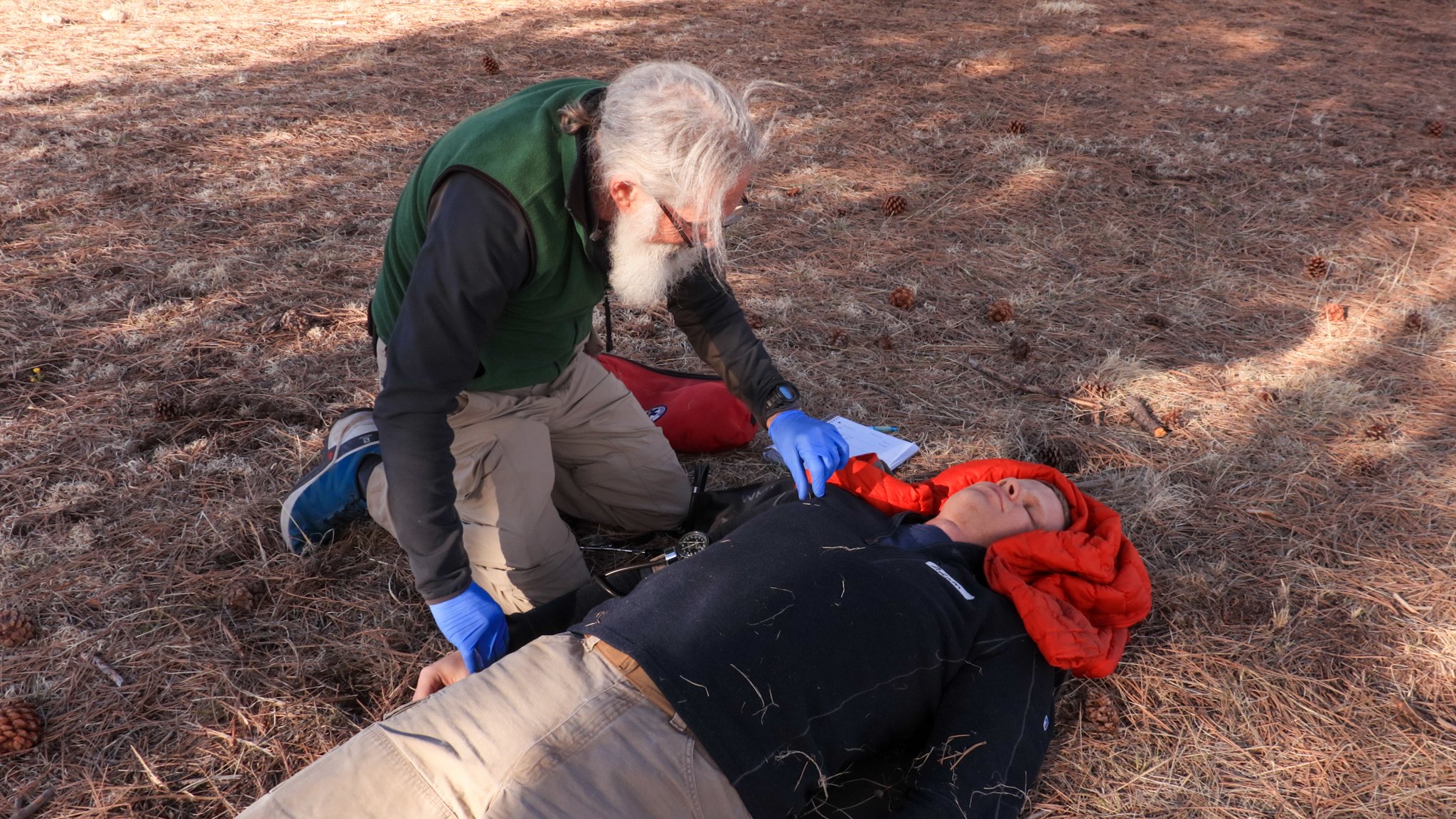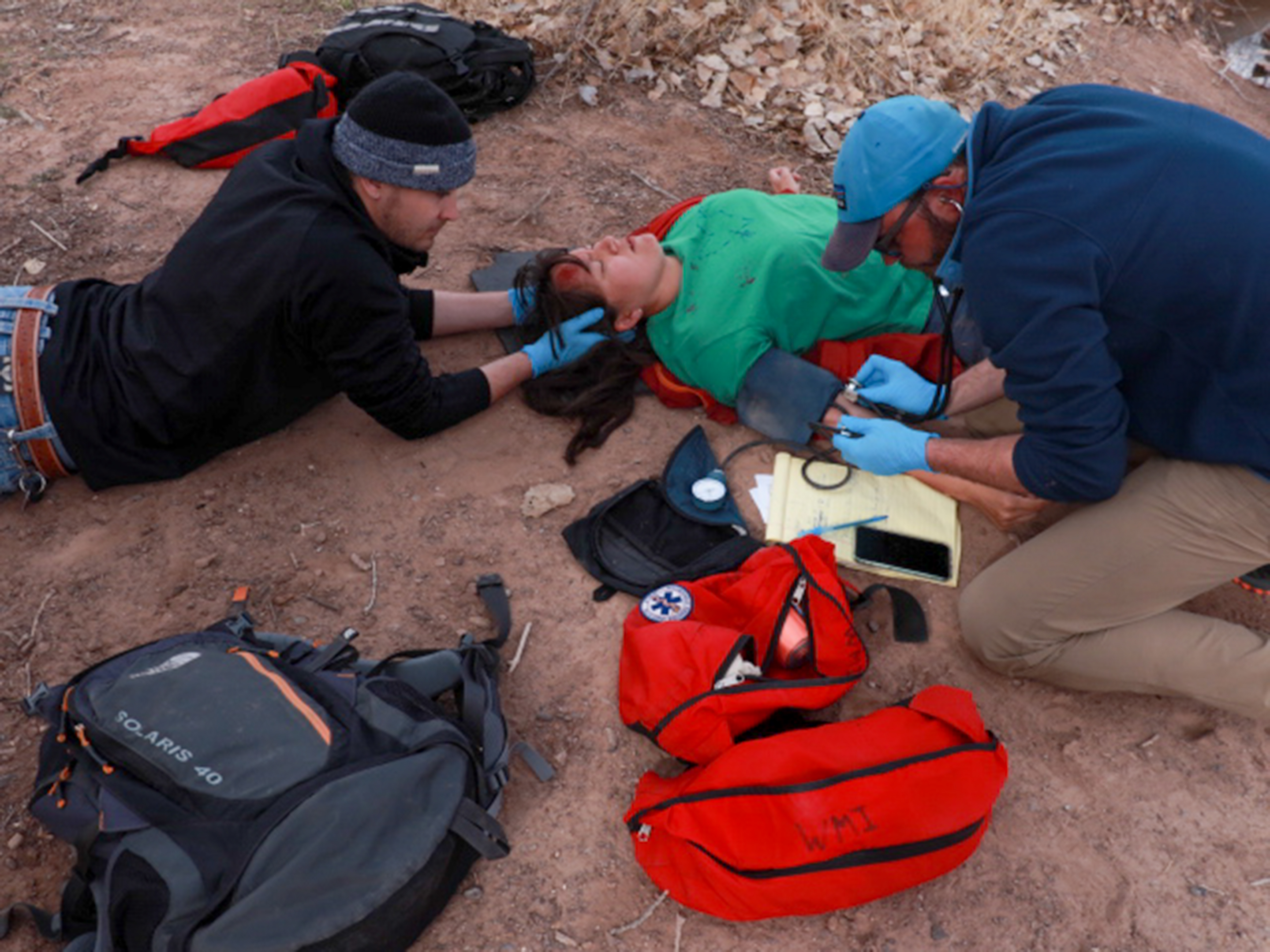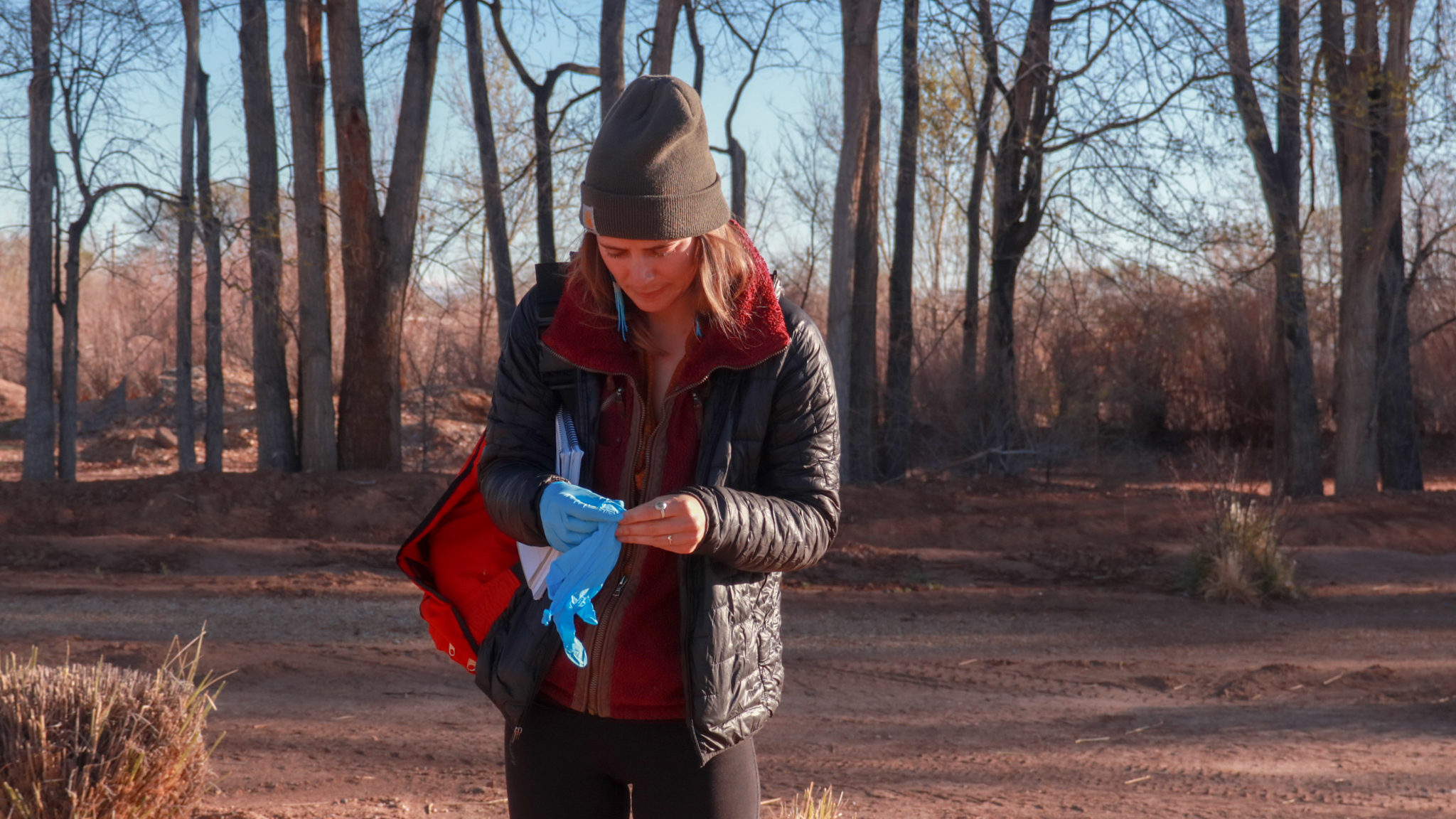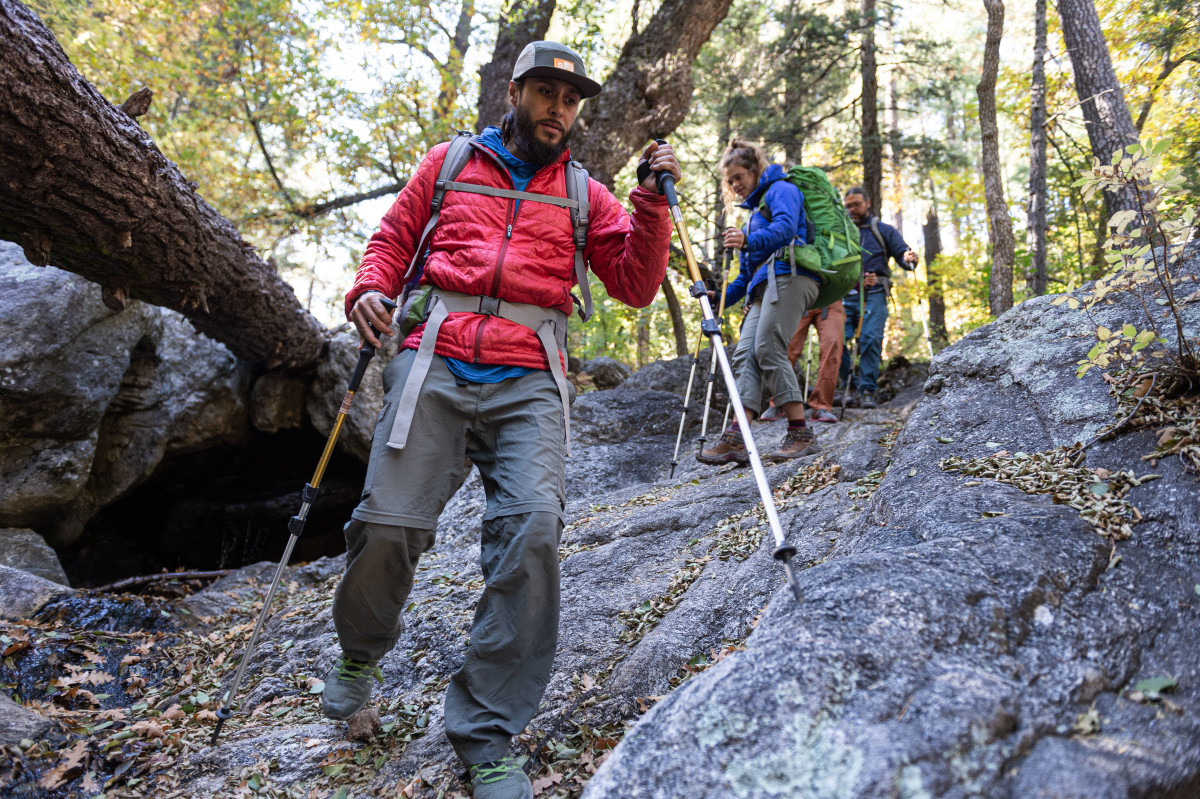
The Setting
You are a local Search and Rescue (SAR) team member with Wilderness First Responder (WFR) training. Your team was dispatched to a remote campground for a reported injury. The coordinates are accurate and you easily find the camp, which is directly off a decent dirt road.
You are greeted by a companion of the injured person who says that about 2 hours ago the patient was climbing a tree to hang a line to keep food from bears. He fell from about 15’ up, landing on his upper back.
In your scene-size up, you see the patient lying on the ground, covered by a sleeping bag with two small backpacks at the side of the head, appearing to serve as blocks.
You stop about 6 feet away from the patient. Following new protocols developed for the COVID 19 pandemic, you apply hand sanitizer, then don gloves, goggles, and an N-95 face mask. You ask if the patient has any flu-like signs or symptoms (fever, cough, muscle, aches) or has been in close contact with someone who has been sick in the last two weeks. If yes, did the sick person test positive for COVID-19?
The patient and their companions deny any of these, so you approach the patient. After obtaining consent, you verify the patient has a good airway and no breathing difficulty. You ask the patient to wear a face mask, and he agrees. You then proceed with the rest of the assessment.
SOAP Report
Subjective
The patient is a 30 year old male who fell about 15’ out of a tree when a branch broke. He landed on his upper back. He did not lose responsiveness. He is complaining of right shoulder and upper back pain.
Objective
Patient Exam
The patient was found on his back. He has no visible injuries. There was no loss of responsiveness. He is complaining of pain in his upper back on the spine and in the surrounding muscles. You find point tenderness on his thoracic spine. CSM are good in all extremities.
Vital Signs
|
Time |
5:30 PM |
6:00 PM |
6:30 PM |
|
Level of Responsiveness (LOR) |
A+Ox4 |
A+Ox4 |
A+Ox4 |
|
Heart Rate (HR) |
76, strong, regular |
80, strong, regular |
76, strong, regular |
|
Respiratory Rate (RR) |
18, regular, easy |
16, regular, easy |
16, regular, easy |
|
Skin Color, Temperature, Moisture (SCTM) |
Pink, warm, dry |
Pink, warm, dry |
Pink, warm, dry |
|
Blood Pressure (BP) |
Strong radial pulse |
Strong radial pulse |
Strong radial pulse |
|
Pupils |
Equal and reactive |
Equal and reactive |
Equal and reactive |
|
Temperature T° |
98°F by infrared on forehead |
98°F by infrared on forehead |
98°F by infrared on forehead |
History
|
Symptoms: |
None |
|
Allergies: |
Denies |
|
Medications: |
Ibuprofen occasionally for muscle aches from exercise |
|
Pertinent Hx: |
None |
|
Last in/out: |
Drank 4 liters of water today, urinated twice with a normal bowel movement this morning |
|
Events: |
The fall from the tree was not caused by a fainting event |
STOP READING!
Think about your plan before scrolling further.

Assessment
Possible spine injury; we have a mechanism as well as thoracic spine pain and tenderness.
Plan
Maintain spine immobilization: patient was log rolled onto a pad, we have applied an improvised cervical collar with a rolled up jacket and there are soft head blocks in place. An ambulance is anticipated to arrive in an hour.
Anticipated problems
If the ambulance does not arrive we have to prepare patient for the night.
The Tale Continues
The ambulance arrives and the crew listens to your SOAP report. They confirm your findings of upper back and spine pain with good CSM, A+O x4, in an alert patient with stable vital signs that are within normal limits. Before lifting the patient onto their cot, they replace your improvised collar with a commercial soft collar. They secure the patient with the cot straps and a set of head blocks. Following proper spine stabilization protocols, they load him into the ambulance and leave to take the patient to definitive care.
After the patient and ambulance crew depart, you carefully remove your PPE (personal protective equipment). You make sure to use hand sanitizer before heading back to base. When you get access to soap and water, you will be sure to thoroughly wash your hands.
Comments: BSI During the COVID-19 Pandemic

Our BSI practices are evolving in light of the COVID 19 pandemic. In addition to the standard practice of wearing gloves to protect against bloodborne pathogens, we also need to protect ourselves and the patient from respiratory pathogens. Assessing the likelihood that the patient has a respiratory illness is part of the scene-size up for many EMS organizations, and in time we may develop WFR decision-making protocols for respiratory illness.
For now, since COVID-19 is always possible, ideally, approach this patient while wearing a mask, gloves, goggles, and a gown.
- The N95 mask, if properly fitted, protects the wearer from inhaling droplets. All other masks somewhat protect the wearer from inhaling particles, but more so keep the wearer from exhaling particles onto other people or surfaces, this is why we mask the patient and wear masks in public. (Masks, in order of preference: N-95, surgical, cloth, improvised)
- Wear eye protection (in order of preference: A face shield, glasses or goggles with full side protection, prescription or sunglasses).
- If you don’t have a protective medical gown, wear a wind or rain layer of clothing.
- And of course, wear your medical gloves. Wash your hands before you don the gloves.
When you are done providing patient care, carefully remove your mask, goggles, gloves, and outer wear. Remove the gloves carefully, without snapping them. Wash your hands. Package what is disposable in a trash bag, and package what you will have carefully cleaned for re-use separately.
Limit personnel on the scene to only those essential for patient care. Ideally, assess and treat the patient outside, rather than in an enclosed space like a tent or shelter. As much as possible, maintain physical distancing during evacuations. Litter carriers should at least wear masks and gloves.
Spine Injury Management

Although the patient is reliable, sober, not distracted, has good CSM, and is A+Ox4, he also has spine pain and tenderness. Based on these findings, there was no reason to perform a focused spine assessment.
After a decade-long anticipatory phase of questioning the need for and merits of the spine immobilization protocols, which were standard urban EMS practices since the early 1970s (backboard, hard cervical collar and head blocks for even the suspicion of a spine mechanism of injury), the last few years have seen dramatic and rapid spread of new protocols.
The incentive for changing practice standards is the absence of studies showing that spinal immobilization prevents further injury, as well as the presence of studies showing that our spinal immobilization practices are possibly causing harm. We worried for decades that moving an injured the spine would worsen the condition. There is no data to support this fear. Paranoia and rigid immobilization are making way for careful handling and comfortable patient packaging. Language is changing from spine immobilization to spine protection.
The new approaches to spine care are evolving and vary among services. Over time they will probably settle into a new set of standards.
Highlights of the changes are:
- Using soft instead of hard cervical collars
- Using backboards primarily as extrication tools, not transport surfaces.
- The modern evolving standard is to place the patient on their back on any firm surface: backboard, stokes, vacuum mattress, cot or, in our wilderness context, the ground. Patients may be transferred to a cot via the backboard, but the backboard is then removed.
NOLS Wilderness Medicine consistently researches new industry information and standards to incorporate into our curriculum. To keep updated on the latest standards, recertify with NOLS Wilderness Medicine.
Written By
Tod Schimelpfenig
As a NOLS Instructor since 1973 and a WEMT, volunteer EMT on ambulance and search and rescue squads since the 70s, Tod Schimelpfenig has extensive experience with wilderness risk management. He has used this valuable experience to conduct safety reviews as well as serve as the NOLS Risk Management Director for eight years, the NOLS Rocky Mountain Director for six years, and three years on the board of directors of the Wilderness Medical Society, where he received the WMS Warren Bowman Award for lifetime contribution to the field of wilderness medicine. Tod is the founder of the Wilderness Risk Manager’s Committee, has spoken at numerous conferences on pre-hospital and wilderness medicine, including the Australian National Conference on Risk Management in Outdoor Recreation, and has taught wilderness medicine around the world. He has written numerous articles on educational program, risk management and wilderness medicine topics, and currently reviews articles for the Journal of Wilderness and Environmental Medicine. Additionally, he is the author of NOLS Wilderness Medicine and co-author of Risk Management for Outdoor Leaders, as well as multiple articles regarding wilderness medicine. Tod is the retired curriculum director for NOLS Wilderness Medicine and is an active wilderness medicine instructor



